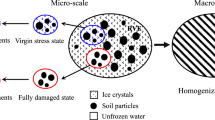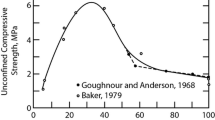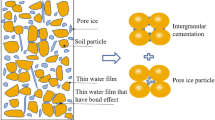Abstract
In cold regions, the deformation characteristics of frozen soils with different coarse-grained contents change significantly under the freeze–thaw (F-T) cycles. A series of cryogenic triaxial compression tests were conducted to investigate the deformation characteristics of frozen soil at −10 °C experiencing freeze–thaw cycles. The results indicated that the stress–strain response is nonlinear, elastoplastic accompanied by strain hardening, and volumetric compaction followed by dilatancy for a given coarse-grained content and F-T cycle. To reveal the aforementioned mechanisms, a micromechanics-based binary-medium constitutive model combining the breakage mechanics for geomaterials theory and the homogenization method is proposed. The following salient features of the proposed model in terms of micro–meso–macro scales are summarized: (i) The frozen soil is idealized as a representative volume element (RVE) at the macroscale, which is composed of elastic bonded elements and elastoplastic frictional elements at the mesoscale. The meso–macro upscaling process for frozen soil is described as the binary-medium constitutive. Furthermore, the Mori–Tanaka method is employed to describe the non-uniform deformation between macro-RVE and mesoscale bonded elements in frozen soil. (ii) At the microscale, the micro–meso upscaling process of the bonded elements is performed by employing the homogenization method which allows for considering the ice cementation breakage and the influence of coarse-grained contents. Meanwhile, for the frictional element, considering the microplastic deformation is related to the frictional sliding mechanism, a Drucker–Prager yield criterion and a non-associate flow rule based on the homogenization approach are proposed. Finally, the developed micromechanics-based binary-medium constitutive model can describe the deformation mechanism of frozen soil from both micro- to meso-scale and from meso- to macro-scale simultaneously, and the deformation of frozen soil with different coarse-grained contents under different F-T cycles is well predicted.




















Similar content being viewed by others
Data availability
The data used to support the findings of this study are available from the corresponding author upon request.
References
Amato G, Ando E, Lyu C et al (2022) A glimpse into rapid freezing processes in clay with x-ray tomography. Acta Geotech 17:327–338
Bignonnet F, Dormieux L, Kondo D (2016) A micro-mechanical model for the plasticity of porous granular media and link with the Cam clay model. Int J Plast 79:259–274
Bikong C, Hoxha D, Shao JF (2015) A micro-macro model for time-dependent behavior of clayey rocks due to anisotropic propagation of microcracks. Int J Plast 69:73–88
Christ M, Kim YC, Park JB (2009) The influence of temperature and cycles on acoustic and mechanical properties of frozen soils. KSCE J Civ Eng 13(3):153–159
Deprez M, Kock DT, Schutter DG et al (2020) A review on freeze-thaw action and weathering of rocks. Earth Sci Rev 203:103143
Du HM, Ma W, Zhang SJ et al (2016) Strength properties of ice-rich frozen silty sands under uniaxial compression for a wide range of strain rates and moisture contents. Cold Reg Sci Technol 123:107–113
Eshelby JD (1957) The determination of the elastic field of an ellipsoidal inclusion, and related problems. Proc Royal Soc London Series A Math Phys Sci 241(1226):376–396
Fish J, Yu Q, Shek K (1999) Computational damage mechanics for composite materials based on mathematical homogenization. Int J Numer Meth Eng 45(11):1657–1679
Ghoreishian ASA, Grimstad G, Kadivar M et al (2016) Constitutive model for rate-independent behavior of saturated frozen soils. Can Geotech J 53(10):1646–1657
Guéry AAC, Cormery F, Shao JF et al (2008) A micromechanical model of elastoplastic and damage behavior of a cohesive geomaterial. Int J Solids Struct 45(5):1406–1429
Hazirbaba K (2019) Effects of freeze-thaw on settlement of fine grained soil subjected to cyclic loading. Cold Reg Sci Technol 160:222–229
He P, Zhu YL, Cheng GD (2000) Constitutive models of frozen soil. Can Geotech J 37(4):811–816
Hill RA (1965) Self-consistent mechanics of composite materials. J Mech Phys Solids 13(4):213–222
Huang Y, Hwang KC, Hu KX et al (1995) A unified energy approach to a class of micromechanics models for composite materials. Acta Mech Sin 11(1):59–75
Kennedy FE, Schulson EM, Jones DE (2000) The friction of ice on ice at low sliding velocities. Philos Mag A 80(5):1093–1110
Kotov PI, Stanilovskaya JYV (2021) Predicting changes in the mechanical properties of frozen saline soils. Eur J Environ Civ En 1–13.
Lai YM, Liao MK, Hu K (2016) A constitutive model of frozen saline sandy soil based on energy dissipation theory. Int J Plast 78:84–113
Lai YM, Xu XT, Dong YH et al (2013) Present situation and prospect of mechanical research on frozen soil in China. Cold Reg Sci Technol 87:6–18
Lai YM, Xu XT, Yu WB et al (2014) An experimental investigation of the mechanical behavior and a hyperplastic constitutive model of frozen loess. Int J Eng Sci 84:29–53
Li B, Zhu ZW, Ning JG et al (2022) Viscoelastic-plastic constitutive model with damage of frozen soil under impact loading and freeze-thaw loading. Int J Mech Sci 214:106890
Li Z, Riska K (2002) Index for estimating physical and mechanical parameters of model ice. J Cold Reg Eng 16(2):72–82
Li ZQ, Hu F, Qi SW et al (2020) Strain-softening failure mode after the post-peak as a unique mechanism of ruptures in a frozen soil-rock mixture. Eng Geol 274:105725
Liu EL, Lai YM (2020) Thermo-poromechanics-based viscoplastic damage constitutive model for saturated frozen soil. Int J Plast 128:102683
Liu EL, Lai YM, Wong H et al (2018) An elastoplastic model for saturated freezing soils based on thermo-poromechanics. Int J Plast 107:246–285
Liu JK, Lv P, Cui YH et al (2014) Experimental study on direct shear behavior of frozen soil-concrete interface. Cold Reg Sci Technol 104:1–6
Liu XY, Liu EL, Zhang D et al (2019) Study on effect of coarse-grained content on the mechanical properties of frozen mixed soils. Cold Reg Sci Technol 158:237–251
Loria AFR, Frigo B, Chiaia B (2017) A non-linear constitutive model for describing the mechanical behaviour of frozen ground and permafrost. Cold Reg Sci Technol 133:63–69
Maghous S, Dormieux L, Barthelemy JF (2009) Micromechanical approach to the strength properties of frictional geomaterials. Eur J Mech-A/Solids 28(1):179–188
Matsuoka N, Murton J (2008) Frost weathering: recent advances and future directions. Permafrost Periglac 19:195–210
Mori T, Tanaka K (1973) Average stress in matrix and average elastic energy of materials with misfitting inclusions. Acta Metall 21(5):571–574
Nassr A, Esmaeili-Falak M, Katebi H et al (2018) A new approach to modeling the behavior of frozen soils. Eng Geol 246:82–90
Oksanen P, Keinonen J (1982) The mechanism of friction of ice. Wear 78(3):315–324
Qi J, Wang S, Yu F (2013) A review on creep of frozen soils. In: Yang Q, Zhang JM, Zheng H, Yao Y (Eds.), Constitutive Modeling of Geomaterials. Verlag Berlin Heidelberg, pp 129–133.
Qi JL, Ma W, Song C (2008) Influence of freeze–thaw on engineering properties of a silty soil. Cold Reg Sci Technol 53(3):397–404
Razbegin VN, Vyalov SS, Maksimyak RV et al (1996) Mechanical properties of frozen soils. Soil Mech Found Eng 33(2):35–45
Shen MD, Zhou ZW, Zhang SJ (2021) Effect of stress path on mechanical behaviours of frozen subgrade soil. Road Mater Pavement 1–30.
Shen WQ, Kondo D, Dormieux L et al (2013) A closed-form three scale model for ductile rock with a plastically compressible porous matrix. Mech Mater 59:73–86
Shen WQ, Shao JF, Kondo D et al (2012) A micro–macro model for clayey rocks with a plastic compressible porous matrix. Int J Plast 36:64–85
Shen ZJ (2006) Progress in binary medium modeling of geological materials. Modern trends in geomechancis, Wu W and Yu HS eds., Springer, Berlin 77–99.
Sun K, Annan Z (2021) A multisurface elastoplastic model for frozen soil. Acta Geotech 16:3401–3424
Ting JM, Torrence MR, Ladd CC (1983) Mechanisms of strength for frozen sand. J Geotech Eng 109(10):1286–1302
Tounsi H, Rouabhi A, Jahangir E et al (2020) Mechanical behavior of frozen metapelite: laboratory investigation and constitutive modeling. Cold Reg Sci Technol 175:103058
Tsubakihara Y, Kishida H, Nishiyama T (1993) Friction between cohesive soils and steel. Soils Found 33(2):145–156
Tsytovich NA, Swinzow E, Tschebotarioff G (1975) The mechanics of frozen ground. McGraw-Hill, New York
Wang P, Liu EL, Zhi B (2021) An elastic-plastic model for frozen soil from micro to macro scale. Appl Math Model 91:125–148
Wang P, Liu EL, Zhi B et al. (2023) A rate-dependent constitutive model for saturated frozen soil considering local breakage mechanism. J Rock Mech Geotech.
Wang P, Liu EL, Zhi B et al (2022) Creep characteristic and unified macro-meso creep model for saturated frozen soil under constant/variable temperature conditions. Acta Geotech 17:5299–5319
Wang SN, Zhu Y, Ma W et al (2021) Effects of rock block and confining pressure on dynamic characteristics of soil-rock mixtures. Eng Geol 280:105963
Yang YG, Feng G, Lai YM et al (2016) Experimental and theoretical investigations on the mechanical behavior of frozen silt. Cold Reg Sci Technol 130:59–65
Yang YG, Lai YM, Chang XX (2010) Laboratory and theoretical investigations on the deformation and strength behaviors of artificial frozen soil. Cold Reg Sci Technol 64:39–45
Yang YH, Wei ZA, Yin GZ et al (2016) Uniaxial compression test of frozen tailings. Cold Reg Sci Technol 129:60–68
Yang ZH, Still B, Ge XX (2015) Mechanical properties of seasonally frozen and permafrost soils at high strain rate. Cold Reg Sci Technol 113:12–19
Yu Q, Zhang ZX, Shen ZY (1993) Instaneous-state deformation and strength behavior of frozen soil. J Glaciol Geocryol 15(2):258–265 ((In Chinese))
Zhang D, Li QM, Liu EL et al (2019) Dynamic properties of frozen silty soils with different coarse-grained contents subjected to cyclic triaxial loading. Cold Reg Sci Technol 157:64–85
Zhang D, Liu EL, Huang J (2020) Elastoplastic constitutive model for frozen sands based on framework of homogenization theory. Acta Geotech 15:1831–1845
Zhang FL, Zhu ZW, Ma W et al (2021) A unified viscoplastic model and strain rate–temperature equivalence of frozen soil under impact loading. J Mech Phys Solids 152:104413
Zhang YG, Liu SH, Lu Y et al (2021) Experimental study of the mechanical behavior of frozen clay-gravel composite. Cold Reg Sci Technol 189:103340
Zhang Z, Ma W, Qi JL (2013) Structure evolution and mechanism of engineering properties change of soils under effect of freeze-thaw cycle. J Jinlin Univ (Earth Sci Ed) 43(6):1904–1914
Zhao LY, Lai YM, Shao JF et al (2021) Friction-damage coupled models and macroscopic strength criteria for ice-saturated frozen silt with crack asperity variation by a micromechanical approach. Eng Geol 294:106405
Zhao LY, Shao JF, Zhu QZ et al (2019) Homogenization of rock-like materials with plastic matrix based on an incremental variational principle. Int J Plast 123:145–164
Zhou MM, Gunther M (2018) A multiscale homogenization model for strength predictions of fully and partially frozen soils. Acta Geotech 13:175–193
Zhou ZW, Ma W, Zhang SJ et al (2020) Experimental investigation of the path-dependent strength and deformation behaviours of frozen loess. Eng Geol 265:105449
Acknowledgements
This study is supported by the funding of the Autonomous Research Topic of the State Key Laboratory of Frozen Soil Engineering, Chinese Academy of Sciences (No. SKLFSE-ZQ-202206) and the funding of the National Natural Science Foundation of China (NSFC) (Grant No. 41771066).
Author information
Authors and Affiliations
Contributions
WD contributed to methodology, investigation, test, model, data curation, writing-original draft. LEL contributed to conceptualization, supervision, funding acquisition, writing—review and editing. YCS contributed to supervision, data curation, writing—review and editing. WP contributed to investigation, data curation. SBT contributed to investigation, test.
Corresponding author
Additional information
Publisher's Note
Springer Nature remains neutral with regard to jurisdictional claims in published maps and institutional affiliations.
Rights and permissions
Springer Nature or its licensor (e.g. a society or other partner) holds exclusive rights to this article under a publishing agreement with the author(s) or other rightsholder(s); author self-archiving of the accepted manuscript version of this article is solely governed by the terms of such publishing agreement and applicable law.
About this article
Cite this article
Wang, D., Liu, E., Yang, C. et al. Micromechanics-based binary-medium constitutive model for frozen soil considering the influence of coarse-grained contents and freeze–thaw cycles. Acta Geotech. 18, 3977–3996 (2023). https://doi.org/10.1007/s11440-023-01831-6
Received:
Accepted:
Published:
Issue Date:
DOI: https://doi.org/10.1007/s11440-023-01831-6




